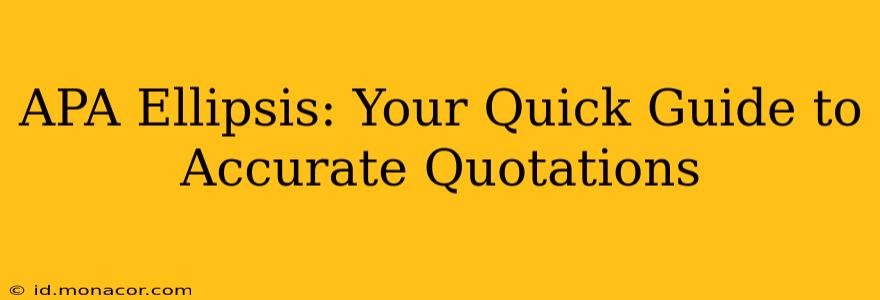Using ellipses correctly in APA style is crucial for maintaining the accuracy and integrity of your research. An ellipsis (...), indicating omitted words within a quote, might seem simple, but mastering its nuances ensures your work is both academically sound and easily understood. This guide will walk you through the proper use of ellipses in APA style, covering common questions and potential pitfalls. We'll explore scenarios, provide examples, and ensure you're confident in using this essential punctuation mark.
What is an Ellipsis in APA Style?
In APA style, an ellipsis (...) represents omitted words, phrases, or sentences within a direct quotation. It signals to the reader that you've shortened the original quote for clarity or brevity, while still maintaining the original meaning. The key is to use ellipses ethically and accurately, ensuring you don't distort the author's intended message.
When Should I Use an Ellipsis in APA?
You'll primarily use an ellipsis when:
- Shortening a quote: If a lengthy quote contains irrelevant information, you can omit it using an ellipsis.
- Focusing on a specific part: You can use an ellipsis to highlight a key section of a quote, omitting the surrounding context.
- Maintaining clarity: Sometimes, a quote might be grammatically complex or contain unnecessary details. An ellipsis allows for simplification without altering the core meaning.
How to Use an Ellipsis Correctly in APA
The APA style guide offers specific rules for ellipsis usage:
- Placement: Place the ellipsis within the quotation marks.
- Spacing: Use three spaced periods (...) to represent the omission.
- Beginning of a quote: If you omit words from the beginning of a quote, do not use an ellipsis at the start.
- End of a quote: If you omit words from the end of a quote, place the ellipsis before the closing quotation marks.
- Omitting a whole sentence: If you omit a full sentence, use four periods (….) – three for the ellipsis and one to represent the ending period.
- Brackets for clarity: If you need to add clarifying words or alter grammar slightly for the flow of your text, enclose these additions in square brackets [ ]. This maintains transparency about any modifications made to the original quote.
Examples of Correct Ellipsis Usage in APA
Example 1 (Omitting words from the middle):
Original Quote: "The quick brown fox jumps over the lazy dog, and the playful kitten chases the ball of yarn."
APA Quote: "The quick brown fox jumps over...the playful kitten chases the ball of yarn."
Example 2 (Omitting words from the beginning and end):
Original Quote: "In the beginning, there was darkness. Then, light appeared, illuminating the world. Eventually, life arose from the primordial soup."
APA Quote: "...light appeared, illuminating the world... "
**Example 3 (Omitting a whole sentence):
Original Quote:** "The experiment was successful. However, further research is needed. The results were surprising."
APA Quote: "The experiment was successful.... The results were surprising."
What if I need to add clarifying words?
If you need to add clarifying words to make the quote's meaning clearer in your context, you should enclose those words within square brackets [ ]. For example:
Original Quote: "The study showed [significant] results."
Common Mistakes to Avoid
- Using too many ellipses: Overuse can disrupt the flow and readability of your text. Only omit words when necessary.
- Altering the meaning: Avoid omitting words in a way that changes the original author's intended meaning.
- Inconsistent spacing: Always use three spaced periods (...) or four (….) for a complete sentence omission.
Conclusion
Mastering the use of ellipses in APA style is crucial for accurate and ethical quotation. By following these guidelines, you can ensure your research papers maintain academic integrity while presenting information concisely and effectively. Remembering the rules and utilizing the examples provided will boost your confidence in using ellipses correctly within your writing.

